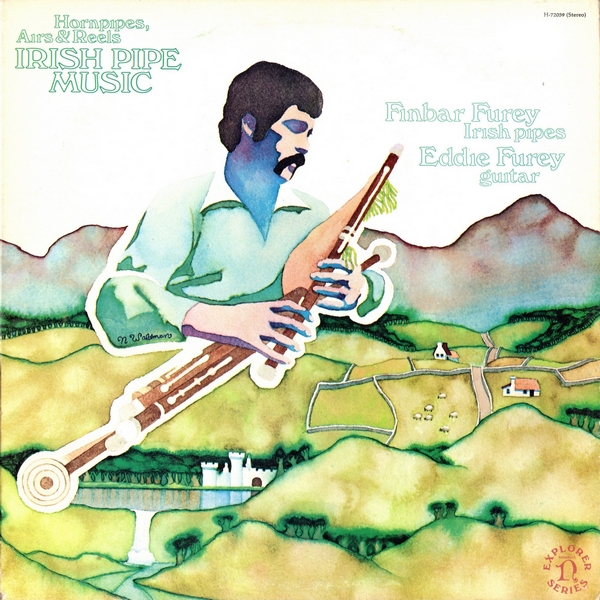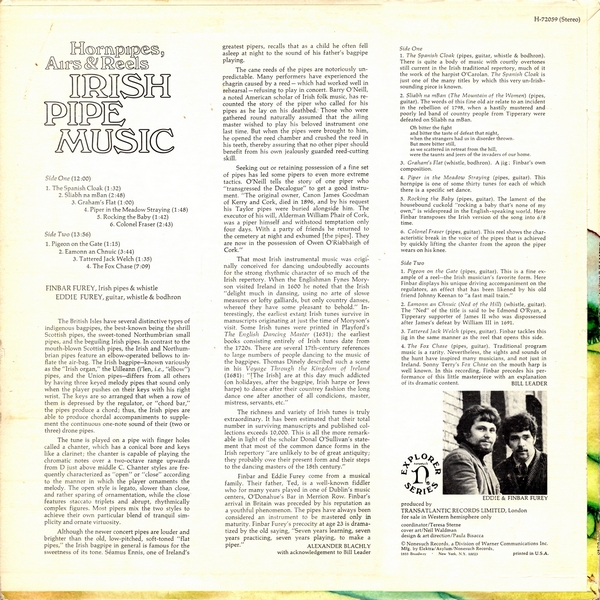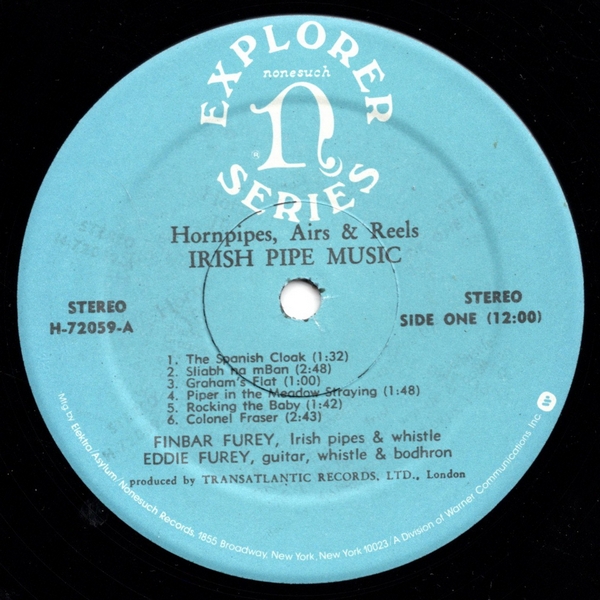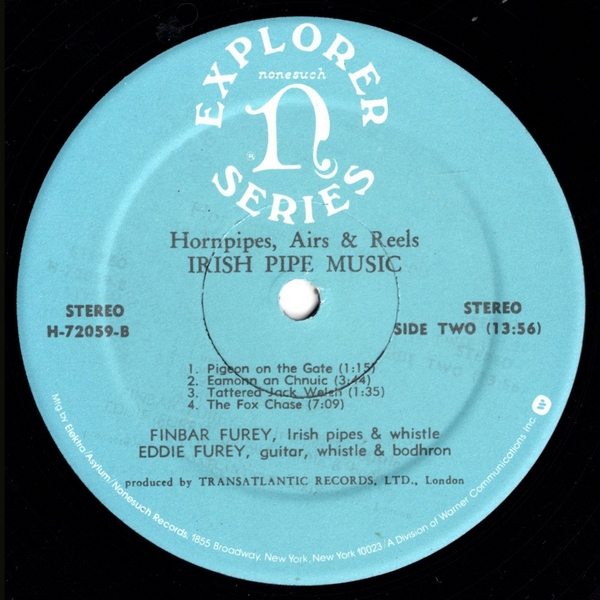

 |



|
Sleeve Notes
The British Isles have several distinctive types of indigenous bagpipes, the best-known being the shrill Scottish pipes, the sweet-toned Northumbrian small pipes, and the beguiling Irish pipes. In contrast to the mouth-blown Scottish pipes, the Irish and Northumbrian pipes feature an elbow-operated bellows to inflate the air-bag. The Irish bagpipe-known variously as the "Irish organ," the Uilleann (ĭ'len, i.e., "elbow") pipes, and the Union pipes-differs from all others by having three keyed melody pipes that sound only when the player pushes on their keys with his right wrist. The keys are so arranged that when a row of them is depressed by the regulator, or "chord bar," the pipes produce a chord; thus, the Irish pipes are able to produce chordal accompaniments to supplement the continuous one-note sound of their (two or three) drone pipes.
The tune is played on a pipe with finger holes called a chanter, which has a conical bore and keys like a clarinet; the chanter is capable of playing the chromatic notes over a two-octave range upwards from D just above middle C. Chanter styles are frequently characterized as "open" or "close" according to the manner in which the player ornaments the melody. The open style is legato, slower than close, and rather sparing of ornamentation, while the close features staccato triplets and abrupt, rhythmically complex figures. Most pipers mix the two styles to achieve their own particular blend of tranquil simplicity and ornate virtuosity.
Although the newer concert pipes are louder and brighter than the old, low-pitched, soft-toned "flat pipes," the Irish bagpipe in general is famous for the sweetness of its tone. Seamus Ennis, one of Ireland's greatest pipers, recalls that as a child he often fell asleep at night to the sound of his father's bagpipe playing.
The cane reeds of the pipes are notoriously unpredictable. Many performers have experienced the chagrin caused by a reed — which had worked well in rehearsal — refusing to play in concert. Barry O'Neill, a noted American scholar of Irish folk music, has recounted the story of the piper who called for his pipes as he lay on his deathbed. Those who were gathered round naturally assumed that the ailing master wished to play his beloved instrument one last time. But when the pipes were brought to him, he opened the reed chamber and crushed the reed in his teeth, thereby assuring that no other piper should benefit from his own jealously guarded reed-cutting skill.
Seeking out or retaining possession of a fine set of pipes has led some pipers to even more extreme tactics. O'Neill tells the story of one piper who "transgressed the Decalogue" to get a good instrument. "The original owner, Canon James Goodman of Kerry and Cork, died in 1896, and by his request his Taylor pipes were buried alongside him. The executor of his will, Alderman William Phair of Cork, was a piper himself and withstood temptation only four days. With a party of friends he returned to the cemetery at night and exhumed [the pipes]. They are now in the possession of Owen O'Riabhaigh of Cork."
That most Irish instrumental music was originally conceived for dancing undoubtedly accounts for the strong rhythmic character of so much of the Irish repertory. When the Englishman Fynes Moryson visited Ireland in 1600 he noted that the Irish "delight much in dansing, using no arte of slowe measures or lofty galliards, but only country danses, whereof they have some pleasant to behold." Interestingly, the earliest extant Irish tunes survive in manuscripts originating at just the time of Moryson's visit. Some Irish tunes were printed in Playford's The English Dancing Master (1651); the earliest books consisting entirely of Irish tunes date from the 1720s. There are several 17th-century references to large numbers of people dancing to the music of the bagpipes. Thomas Dinely described such a scene in his Voyage Through the Kingdom of Ireland (1681): "[The Irish] are at this day much addicted (on holidayes, after the bagpipe, Irish harps or Jews harpe) to dance after their countrey fashion the long dance one after another of all condicions, master, mistress, servants, etc."
The richness and variety of Irish tunes is truly extraordinary. It has been estimated that their total number in surviving manuscripts and published collections exceeds 10,000. This is all the more remarkable in light of the scholar Donal O'Sullivan's statement that most of the common dance forms in the Irish repertory "are unlikely to be of great antiquity; they probably owe their present form and their steps to the dancing masters of the 18th century."
Finbar and Eddie Furey come from a musical family. Their father, Ted, is a well-known fiddler who for many years played in one of Dublin's music centers, O'Donahue's Bar in Merrion Row. Finbar's arrival in Britain was preceded by his reputation as a youthful phenomenon. The pipes have always been considered an instrument to be mastered only in maturity. Finbar Furey's precocity at age 23 is dramatized by the old saying, "Seven years learning, seven years practicing, seven years playing, to make a Piper."
Alexander Blachly with acknowledgement to Bill Leader
The Spanish Cloak (pipes, guitar, whistle & bodhron). There is quite a body of music with courtly overtones still current in the Irish traditional repertory, much of it the work of the harpist O'Carolan. The Spanish Cloak is just one of the many titles by which this very un-Irish-sounding piece is known.
Sliabh na mBan (The Mountain of the Women) (pipes, guitar). The words of this fine old air relate to an incident in the rebellion of 1798, when a hastily mustered and poorly led band of country people from Tipperary were defeated on Sliabh na mBan.
Oh bitter the fight
and bitter the taste of defeat that night,
when the strangers had us in disorder thrown.
But more bitter still,
as we scattered in retreat from the hill,
were the taunts and jeers of the invaders of our home.
Graham's Plat (whistle, bodhron). A jig ; Finbar's own composition.
Piper in the Meadow Straying (pipes, guitar). This hornpipe is one of some thirty tunes for each of which there is a specific set dance.
Rocking the Baby (pipes, guitar). The lament of the housebound cuckold "rocking a baby that's none of my own" is widespread in the English-speaking world. Here Finbar transposes the Irish version of the song into 6/8 time.
Colonel Eraser (pipes, guitar). This reel shows the characteristic break in the voice of the pipes that is achieved by quickly lifting the chanter from the apron the piper wears on his knee.
Pigeon on the Gate (pipes, guitar). This is a fine example of a reel—the Irish musician's favorite form. Here Finbar displays his unique driving accompaniment on the regulators, an effect that has been likened by his old friend Johnny Keenan to "a fast mail train."
Eamonn an Chnuic (Ned of the Hill) (whistle, guitar). The "Ned" of the title is said to be Edmond O'Ryan, a Tipperary supporter of James II who was dispossessed after James's defeat by William III in 1691.
Tattered lack Welch (pipes, guitar). Finbar tackles this jig in the same manner as the reel that opens this side.
The Fox Chase (pipes, guitar). Traditional program music is a rarity. Nevertheless, the sights and sounds of the hunt have inspired many musicians, and not just in, Ireland. Sonny Terry's Fox Chase on the mouth harp is well known. In this recording, Finbar precedes his performance of this little masterpiece with an explanation of its dramatic content.
BILL LEADER